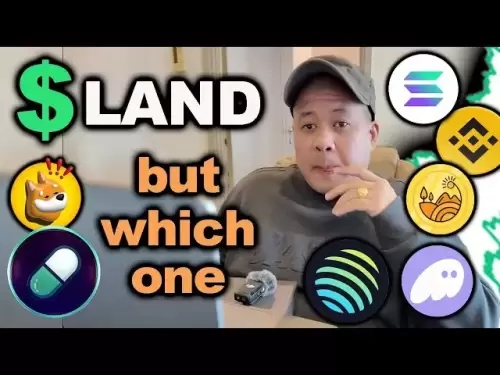-
 Bitcoin
Bitcoin $118600
0.36% -
 Ethereum
Ethereum $3855
1.06% -
 XRP
XRP $3.195
-0.09% -
 Tether USDt
Tether USDt $1.000
-0.04% -
 BNB
BNB $844.5
6.23% -
 Solana
Solana $191.3
2.83% -
 USDC
USDC $0.9997
-0.01% -
 Dogecoin
Dogecoin $0.2376
0.10% -
 TRON
TRON $0.3242
0.83% -
 Cardano
Cardano $0.8222
0.13% -
 Hyperliquid
Hyperliquid $45.26
6.53% -
 Sui
Sui $4.200
-2.56% -
 Stellar
Stellar $0.4336
-1.24% -
 Chainlink
Chainlink $18.86
0.28% -
 Hedera
Hedera $0.2796
-1.75% -
 Bitcoin Cash
Bitcoin Cash $583.3
-1.84% -
 Avalanche
Avalanche $27.06
8.09% -
 Litecoin
Litecoin $112.3
-1.16% -
 Toncoin
Toncoin $3.353
0.58% -
 UNUS SED LEO
UNUS SED LEO $8.968
-0.11% -
 Shiba Inu
Shiba Inu $0.00001395
-0.54% -
 Ethena USDe
Ethena USDe $1.001
-0.03% -
 Uniswap
Uniswap $10.76
0.69% -
 Polkadot
Polkadot $4.175
0.26% -
 Monero
Monero $326.7
1.07% -
 Bitget Token
Bitget Token $4.665
1.61% -
 Dai
Dai $0.9998
-0.02% -
 Pepe
Pepe $0.00001271
0.32% -
 Cronos
Cronos $0.1416
2.01% -
 Aave
Aave $299.3
1.15%
How to manage risk when trading Gate.io futures?
Futures trading on Gate.io offers leverage and advanced tools like stop-loss, take-profit, and partial liquidation—but success hinges on disciplined risk management.
Jul 28, 2025 at 04:21 pm

Understanding Futures Trading on Gate.io
Futures trading on Gate.io allows traders to speculate on the price movement of cryptocurrencies without owning the underlying asset. Unlike spot trading, futures involve leverage, which can amplify both profits and losses. It's essential to understand how contracts work—each futures contract has an expiration date, leverage options (e.g., 2x to 100x), and a liquidation price. If the market moves against your position and hits that liquidation price, your position will be automatically closed. This mechanism makes risk management not just important—it's mandatory. Proper leverage selection is the cornerstone of sustainable futures trading, and beginners should avoid maxing out leverage even if the platform allows it.
Setting Stop-Loss and Take-Profit Orders
Stop-loss (SL) and take-profit (TP) orders are automated tools that help lock in gains and prevent catastrophic losses. When opening a futures position on Gate.io, always set these parameters manually rather than relying on market sentiment.
- Navigate to the order panel after selecting your futures contract.
- Under “Advanced Orders,” enable “Stop-Loss / Take-Profit.”
- Input your desired SL price (below entry for longs, above for shorts) and TP price (above entry for longs, below for shorts).
- Confirm the order size and click “Place Order.”
These orders execute automatically when the market reaches your specified levels, eliminating emotional decision-making during volatile swings. Never trade without them—this is a non-negotiable step for risk control.Calculating Position Size Based on Risk Tolerance
One of the most overlooked aspects of futures trading is proper position sizing. A common rule is to risk no more than 1–2% of your total trading capital per trade. For example, if your account balance is $10,000, never risk more than $200 on a single trade. To calculate position size: - Determine your maximum risk amount (e.g., $200).
- Decide your stop-loss distance in percentage terms (e.g., 5%).
- Divide your risk amount by the stop-loss percentage: $200 / 0.05 = $4,000.
This means your position size should be $4,000—not the full account balance. This method ensures consistent risk exposure across trades, protecting your capital from sudden drawdowns.Monitoring Liquidation Price and Margin Level
Gate.io displays your liquidation price and margin level in real time within the position tab. These metrics are critical because they show how close your trade is to being forcibly closed. The liquidation price is calculated based on your entry price, leverage, and fees. If the market moves toward that price, consider reducing position size or adding margin manually. Margin level is shown as a percentage—when it drops below 100%, liquidation is imminent. Traders must check these values constantly, especially during high volatility. Ignoring margin warnings is the fastest way to lose your entire position, so set up price alerts or use Gate.io’s mobile app for live updates.Using Gate.io’s Insurance Fund and Partial Liquidation Features
Gate.io offers built-in safety nets like the insurance fund and partial liquidation to reduce the impact of sudden market moves. The insurance fund absorbs losses when positions are liquidated at unfavorable prices, preventing clawbacks from other traders. Partial liquidation means only a portion of your position is closed if margin falls too low—this gives you a chance to recover instead of losing everything at once. To benefit from these features: - Avoid over-leveraged positions that exceed the system’s liquidation buffer.
- Keep an eye on the “Insurance Balance” in your futures account.
- Understand that partial liquidation preserves part of your trade, allowing you to adjust SL or add margin.
These tools are not a substitute for active risk management, but they do offer breathing room when markets behave unpredictably.Common Risk Management Mistakes to Avoid
Many traders fail not because of poor strategy but because of behavioral errors. One major mistake is re-entering a losing trade immediately after liquidation—a behavior known as “revenge trading.” Another is ignoring funding rates in perpetual futures, which can erode profits over time if held too long. Also, some traders neglect to check their order types: using a market order instead of a limit order can lead to slippage during fast-moving markets. Always review your trade history in Gate.io’s “Orders” tab to spot patterns in losses. Awareness of these pitfalls is the first line of defense against repeated failures.FAQs
What happens if my futures position gets liquidated on Gate.io?
If your margin level hits 100%, Gate.io automatically closes your position at the current market price. Any remaining funds after covering losses go to the insurance fund. You won’t owe additional money, but you lose the full margin allocated to that trade.Can I change my leverage after opening a futures position on Gate.io?
Yes. Go to the “Positions” tab, find your open trade, and click “Adjust Leverage.” Be cautious—increasing leverage lowers your liquidation price, making the position riskier.How does Gate.io calculate unrealized PnL in futures?
Unrealized PnL is calculated using the formula:(Mark Price – Entry Price) × Position Size × Contract Multiplier
For long positions, a higher mark price increases unrealized profit. For shorts, a lower mark price does the same.Is it safe to hold perpetual futures contracts overnight on Gate.io?
It depends on funding rates and market conditions. Perpetual contracts charge or pay funding fees every 8 hours. Check the “Funding Rate” indicator before holding overnight—positive rates mean you pay; negative rates mean you earn.
Disclaimer:info@kdj.com
The information provided is not trading advice. kdj.com does not assume any responsibility for any investments made based on the information provided in this article. Cryptocurrencies are highly volatile and it is highly recommended that you invest with caution after thorough research!
If you believe that the content used on this website infringes your copyright, please contact us immediately (info@kdj.com) and we will delete it promptly.
- Tinubu's Grand Gesture: Super Falcons Soar with Rewards and Recognition
- 2025-07-29 02:30:12
- Rare Coin Sells for £180,000 at Auction: A Glimpse into Numismatic Treasures
- 2025-07-29 02:30:12
- Pepe Dollar vs. Bitcoin HYPER: The Crypto Supercycle Meme Showdown
- 2025-07-29 01:10:12
- BlockDAG, BNB, DOGE: The New York Minute on 2025's Crypto Frontrunners
- 2025-07-29 01:50:12
- AVAX, Solana, and the AI Token Surge: What's Hot and What's Not
- 2025-07-29 01:50:12
- XRP Price Surge Potential: Chart Analysis and What's Next
- 2025-07-29 01:55:48
Related knowledge

Why is my Bitstamp futures position being liquidated?
Jul 23,2025 at 11:08am
Understanding Futures Liquidation on BitstampFutures trading on Bitstamp involves borrowing funds to open leveraged positions, which amplifies both po...

Does Bitstamp offer inverse contracts?
Jul 23,2025 at 01:28pm
Understanding Inverse Contracts in Cryptocurrency TradingIn the realm of cryptocurrency derivatives, inverse contracts are a specific type of futures ...

What is the difference between futures and perpetuals on Bitstamp?
Jul 27,2025 at 05:08am
Understanding Futures Contracts on BitstampFutures contracts on Bitstamp are financial derivatives that allow traders to speculate on the future price...

How to find your Bitstamp futures trade history?
Jul 23,2025 at 08:07am
Understanding Bitstamp and Futures Trading AvailabilityAs of the current state of Bitstamp’s service offerings, it is critical to clarify that Bitstam...

Can I use a trailing stop on Bitstamp futures?
Jul 23,2025 at 01:42pm
Understanding Trailing Stops in Cryptocurrency TradingA trailing stop is a dynamic type of stop-loss order that adjusts automatically as the price of ...

Can I use a trailing stop on Bitstamp futures?
Jul 25,2025 at 02:28am
Understanding Trailing Stops in Cryptocurrency Futures TradingA trailing stop is a dynamic type of stop-loss order that adjusts automatically as the m...

Why is my Bitstamp futures position being liquidated?
Jul 23,2025 at 11:08am
Understanding Futures Liquidation on BitstampFutures trading on Bitstamp involves borrowing funds to open leveraged positions, which amplifies both po...

Does Bitstamp offer inverse contracts?
Jul 23,2025 at 01:28pm
Understanding Inverse Contracts in Cryptocurrency TradingIn the realm of cryptocurrency derivatives, inverse contracts are a specific type of futures ...

What is the difference between futures and perpetuals on Bitstamp?
Jul 27,2025 at 05:08am
Understanding Futures Contracts on BitstampFutures contracts on Bitstamp are financial derivatives that allow traders to speculate on the future price...

How to find your Bitstamp futures trade history?
Jul 23,2025 at 08:07am
Understanding Bitstamp and Futures Trading AvailabilityAs of the current state of Bitstamp’s service offerings, it is critical to clarify that Bitstam...

Can I use a trailing stop on Bitstamp futures?
Jul 23,2025 at 01:42pm
Understanding Trailing Stops in Cryptocurrency TradingA trailing stop is a dynamic type of stop-loss order that adjusts automatically as the price of ...

Can I use a trailing stop on Bitstamp futures?
Jul 25,2025 at 02:28am
Understanding Trailing Stops in Cryptocurrency Futures TradingA trailing stop is a dynamic type of stop-loss order that adjusts automatically as the m...
See all articles

























































































